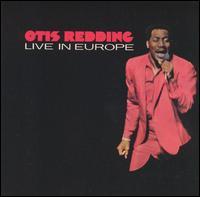Otis Rocks Europe! Or Does He?
I've always wondered whether Otis Redding's Live in Europe, newly reissued on vinyl by Sundazed, was actually recorded in Europe. Frankly, I doubt it. The liner notes quote Redding reviews from Paris and the various cities in the UK, but they also refer to a Stax-Volt review featuring many artists, none of whom were given an album's worth of stage time, that's a guarantee.I've always wondered whether Otis Redding's Live in Europe, newly reissued on vinyl by Sundazed, was actually recorded in Europe. Frankly, I doubt it. The liner notes quote Redding reviews from Paris and the various cities in the UK, but they also refer to a Stax-Volt review featuring many artists, none of whom were given an album's worth of stage time, that's a guarantee. The audience here sounds as if it is predominantly Southern black Americans, and it's not racist to say you can tell the race and nationality of the woman who screams at Otis, "Sing 'Good to Me,' baby!" And the opening announcer sounds generically white-bread American (Little Feat's announcer on Waiting For Columbus copped this dude's riff). Maybe he was part of Redding's traveling entourage, but I doubt that too. Not that it matters where this supercharged performance took place.
That out of the way: this is easily one of the most exciting live pop-music recordings ever made. As far as I'm concerned, Live in Europe leaves James Brown's Live at the Apollo in the dust--at least in the excitement department. Redding knew only one energy level, and that was pedal-to-the-metal--even when singing a ballad. He was the gruff, raw, gospel-infused country boy to crooner Smokey Robinson's velvet pipes, and when Redding tackles "My Girl" (a hit for The Temptations), he brings to the song an urgency that Robinson probably never imagined.
Backed by a band that sounds like the Cropper/Dunn/Booker T./Memphis Horn conglomeration, Redding tears through some of his own hits ("Respect," "Can't Turn You Loose," "I've Been Loving You Too Long [To Stop Now]," and others) and the hits of others, including Smokey, Sam Cooke, Jagger/Richards' "Satisfaction," and Lennon/McCartney's "Day Tripper." He also re-writes the book on the old chestnut "Try a Little Tenderness," recorded in 1933 by Bing Crosby--something lost on most 1960s twenty-somethings who figured the song was written for Otis.
With his signature "gotta, gotta have-its," Redding turns "Satisfaction" from a wry social statement into a burning plea. Same with "Day Tripper." No doubt the English duos were thrilled by Redding's coverage, and if you haven't heard this record, so will you. Redding's energy level seems impossibly high, yet despite the shouting match he's having with himself, the man is always in complete and perfect control of his voice. And listen to how skillfully he works the absolutely unruly, screaming, and often rude-as-shit (though adoring) crowd.
The closing "Try a Little Tenderness" is, for me, the single most exciting, goose-bump-delivering moment in live recorded history. Starting uncharacteristically low in level, Redding eventually drives the song to new peaks of energy and excitement as he implores the audience again and again with its refrain. He leaves the stage to a frenzied audience pouring his energy back at him and returns for a few more refrains at an even higher energy level, which the audience returns, and then--mercifully--the engineer fades out while the audience is coasting on a high. I have played this record for 35+ years, and it still gets me the way it did on first play.
The emotional effect is aided and abetted by an absolutely phenomenal recording of Redding, band, and audience, which is only appropriate, as the audience is part of the show. The recording is nothing fancy, mind you, in terms of imaging and staging, but it is so simple and so transparent and alive, thanks to a really lively (but never hard or harsh) top end. Redding, in particular, is center stage, right up-front, and 3D glasses three dimensional. The band is split mostly left/right, but it works okay, and the audience is divided into two sections: those sitting right on the stage mics, and those seemingly sitting in the balcony. There will be people applauding in the left channel who sound as if they were sitting with the mics in their laps, and others way back.
Sundazed's remastering is outstanding and captures the spirit and intent of the original--especially at the top end. Big, deep bass was never a signature of the Stax-Volt sound, and this live recording mirrors that. Bob Irwin steered clear of bumping up the bass and that's a real plus. The original seems to have had a bit of artificial reverb added to it, because it sounds like a much bigger venue on the original, with an obvious sense of a distant, high balcony that seems to be absent from the reissue, which makes the venue sound smaller and more intimate. Sundazed's rendering is more transparent, yet with meatier images (probably due to the absence of the reverb). And its dead-silent backgrounds intensify the illusion of really being there. A no-brainer, must-have album.




